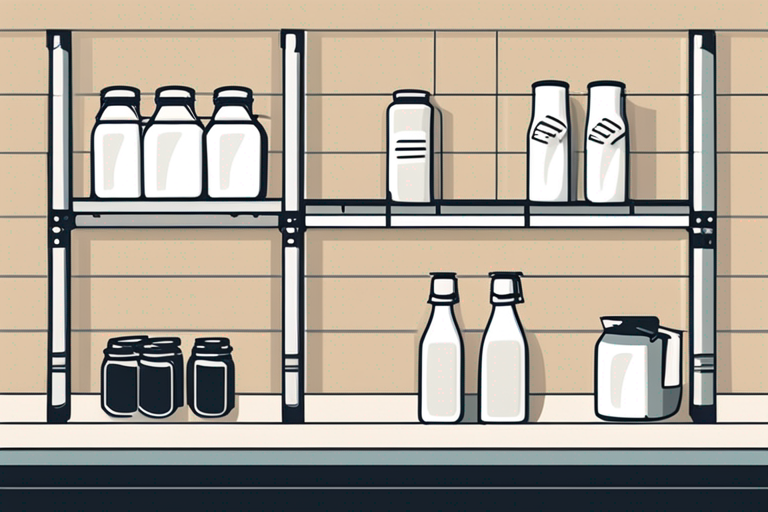
Understanding Dry Milk Expiration: Safety, Storage, and Shelf Life
Get Your Free Food Safety Cheat Sheet
30 most common foods with instant answers. Print it and stick it on your fridge—completely free!
Understanding Dry Milk Expiration: Safety, Storage, and Shelf Life
In today's blog post, we will delve into the topic of dry milk expiration dates. Many of us have dry milk powder in our pantry for various uses, from baking to cooking. However, it's essential to understand how long dry milk lasts, how to store it properly, and when it's time to discard it for safety reasons. Let's explore all you need to know about dry milk expiration.
How Long Does Dry Milk Last?
Dry milk, also known as powdered milk, typically comes with a "best by" or "use by" date on the packaging. This date indicates the manufacturer's recommendation for the product's peak quality. However, it's crucial to note that this date is not an expiration date but rather a guideline.
Factors Affecting Dry Milk Shelf Life
Several factors can influence the shelf life of dry milk:
-
Storage Conditions: Proper storage is key to maintaining the quality of dry milk. Exposure to heat, light, moisture, and air can accelerate spoilage.
-
Packaging: The packaging of dry milk plays a significant role in its shelf life. Airtight containers or sealed pouches help protect the powder from moisture and air.
-
Quality of Powder: The quality of the dry milk powder itself can impact its longevity. High-quality powder tends to have a longer shelf life.
Real-Life Scenarios
Understanding dry milk expiration can be particularly relevant in various everyday scenarios. For instance, imagine a busy parent baking cookies for a school event. In their hurry, they grab a container of dry milk from their pantry, only to discover it has an off smell once mixed into the batter. This situation not only leads to wasted ingredients but also creates a potential health risk if the spoiled milk were consumed.
Another scenario could involve someone preparing for a camping trip. They pack dry milk to make instant oatmeal for breakfast. If they fail to check the expiry date and later find that the dry milk has been spoiled, it could throw off their meal plans and leave them with fewer nutrition options in the great outdoors.
Finally, consider an unexpected visit from friends. You decide to whip up a batch of homemade whipped cream using dry milk, only to realize the powder has clumped together and developed an unpleasant odor. If only you had stored it properly and checked for signs of spoilage beforehand!
In another relatable instance, think of someone trying to recreate a family recipe that calls for dry milk. After searching the pantry and finding a long-forgotten bag, they might be convinced it's still good. But once they taste the final dish, they realize the milk has affected the flavor, turning what should have been a nostalgic treat into a disappointing meal.
A final scenario could involve a student living in a dorm. They opt for dry milk as a convenient and non-perishable option for their morning cereal. However, if they neglect to store it properly, they might end up with a lumpy, off-tasting addition to their breakfast, leading them to seek out alternatives and wasting their money.
Proper Storage of Dry Milk
To ensure your dry milk stays fresh and safe for consumption, follow these storage guidelines:
Storage Container
- Use airtight containers or resealable bags to store dry milk.
- Ensure the container is clean and free from any moisture before transferring the powder.
- Opt for opaque containers to protect the powder from light exposure.
Storage Conditions
- Store dry milk in a cool, dry place away from direct sunlight and heat sources.
- Avoid storing dry milk near strong-smelling foods as it can absorb odors.
- Keep the storage area well-ventilated to prevent moisture buildup.
Shelf Life Extension Tips
- Consider storing dry milk in the refrigerator or freezer for extended shelf life.
- Vacuum-sealing the powder can help preserve its quality for a longer duration.
Additional Storage Methods
In addition to basic storage tips, you might want to explore some alternative methods. For example, if you're a long-term prepper or just like to buy in bulk, consider using mylar bags with oxygen absorbers. This method works wonders for long-term storage, extending the shelf life significantly beyond what you'd achieve with regular containers.
Another less conventional but effective method is incorporating silica gel packets into your dry milk storage. These packets can help absorb excess moisture, further preventing clumping and spoilage.
If you often use dry milk in smaller quantities, consider portioning it out into single-use packets or jars. This way, you can avoid exposing the entire supply to air and moisture every time you need a small amount.
Signs of Spoiled Dry Milk
It's essential to be able to recognize the signs of spoiled dry milk to avoid consuming potentially harmful products. Here are some indicators that your dry milk may have gone bad:
- Off Odor: If the dry milk has a sour or rancid smell, it is likely spoiled.
- Unusual Texture: Clumping, discoloration, or unusual texture changes indicate spoilage.
- Taste Test: If the dry milk tastes off or different from its usual flavor, it should be discarded.
Common Mistakes with Dry Milk
Many people misunderstand the shelf life of dry milk and often confuse "best by" dates with expiration dates. While the product may still be safe to consume past the best-by date, the quality could degrade. It’s not uncommon for someone to assume that if it’s past that date, it's automatically unsafe. However, proper storage and inspection can often mean using it safely for months or even years after that date.
Another common mistake is not sealing the container properly after opening. Even if you’re diligent about storing it in an airtight container, if you forget to seal it tightly after use, you risk introducing moisture and air, which can lead to rapid spoilage.
Safety Precautions and Best Practices
When using dry milk in recipes or beverages, keep the following safety tips in mind:
- Always follow proper reconstitution instructions provided on the packaging.
- Avoid consuming expired dry milk or powder that shows signs of spoilage.
- Use dry milk within a reasonable timeframe for the best quality and taste.
Expert Insights
As a food safety expert, I often remind people that dry milk, when stored correctly, can provide excellent nutritional value. It’s a source of protein, calcium, and essential vitamins like A and D, making it a great addition to various recipes.
Interestingly, some studies have shown that dry milk can retain its nutritional quality for years when stored in optimal conditions, making it a valuable asset for emergency preparedness. Many people don't realize that dry milk can be a lifesaver during unexpected situations, providing essential nutrients when fresh milk isn’t available.
Additionally, consider using dry milk in less conventional ways. For instance, it can be a fantastic thickening agent for soups and sauces or even a nutritious booster in smoothies. By understanding how to utilize dry milk effectively, you not only minimize waste but also enhance your meals.
Nutritional Information
When discussing dry milk, it's important to mention its nutritional profile. One cup of reconstituted whole dry milk typically contains around 150 calories, 8 grams of protein, and 5 grams of fat. Nonfat dry milk offers a comparable protein content while cutting back significantly on calories and fat, making it a popular choice for those watching their intake.
This nutritional value can make dry milk an excellent option for individuals looking to add quality protein to their diets without the need for refrigeration. It’s also a versatile ingredient that can be adapted for various dietary needs. For instance, those following a lactose-free diet may find that reconstituted dry milk suits their needs better than fresh options, as the processing can sometimes make it easier to digest.
Moreover, dry milk can be an excellent addition to baked goods, offering moisture and a rich flavor profile without the need for perishable dairy. From pancakes to bread, incorporating dry milk can elevate your recipes while ensuring you always have milk on hand.
Conclusion
In conclusion, understanding dry milk expiration dates and proper storage practices is essential for maintaining food safety. By following the guidelines outlined in this post, you can ensure that your dry milk remains fresh, flavorful, and safe for consumption. Remember to check the packaging for recommended storage instructions and be vigilant for signs of spoilage. Proper storage and handling of dry milk will help you enjoy its benefits for an extended period without compromising quality or safety.
If you have any additional questions or tips to share regarding dry milk expiration, feel free to leave a comment below. Stay informed, stay safe, and enjoy your culinary adventures with confidence!

Authoritative Food Safety References
These agencies and university labs inform every tip and health precaution we publish.
USDA FoodKeeper – Cold Storage Guidelines
Official refrigerator, freezer, and pantry timelines maintained by the U.S. Department of Agriculture.
Visit USDA FoodKeeperFDA Produce Safety Rule & Grower Guidance
Field-to-fridge handling practices that prevent contamination of fruits, vegetables, and leafy greens.
Visit FDA Produce SafetyCDC Foodborne Illness Prevention Hub
Surveillance-backed guidance on pathogens, symptoms, and steps to reduce foodborne illness risk.
Visit CDC Food SafetyUC Davis Postharvest Technology Center
University research detailing optimal storage atmospheres for produce after harvest.
Visit UC Davis PostharvestPenn State Extension – Home Food Preservation & Safety
Peer-reviewed extension bulletins on safe canning, chilling, and reheating practices.
Visit Penn State ExtensionHow long does dry milk last after the expiration date?
How should dry milk be stored to maximize shelf life?
Can you freeze dry milk to prolong its shelf life?
How can you tell if dry milk has gone bad?
Is it safe to use expired dry milk in baking or cooking?
Get Your Free Food Safety Cheat Sheet
30 most common foods with instant answers. Print it and stick it on your fridge—completely free! Want more? Upgrade to the complete guide with 70+ foods.
Scan your food directly and get instant safety info using our AI-powered camera feature.